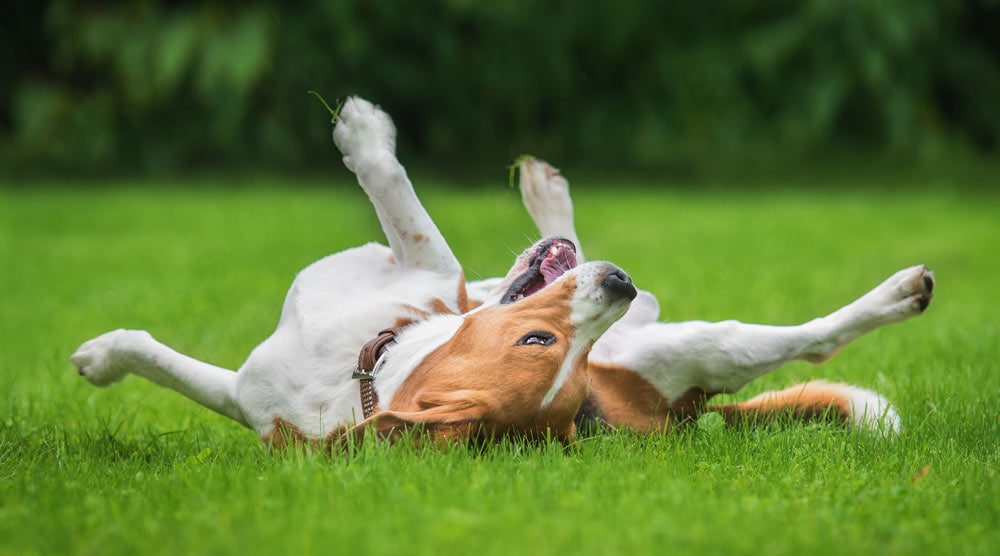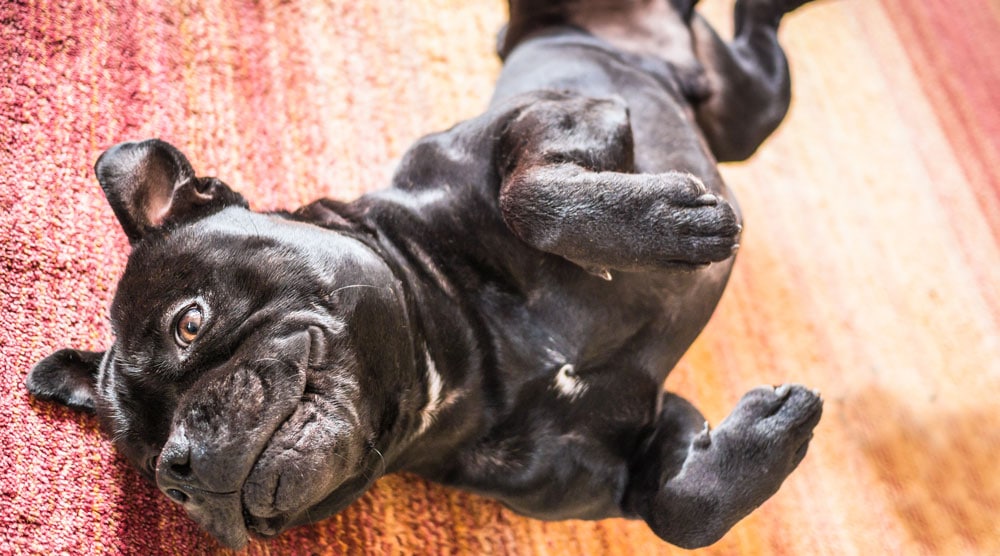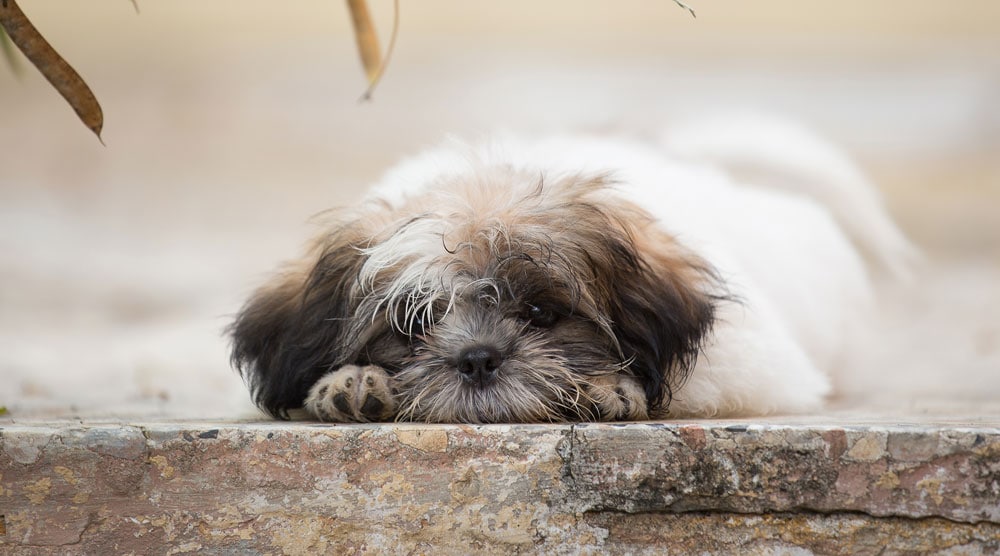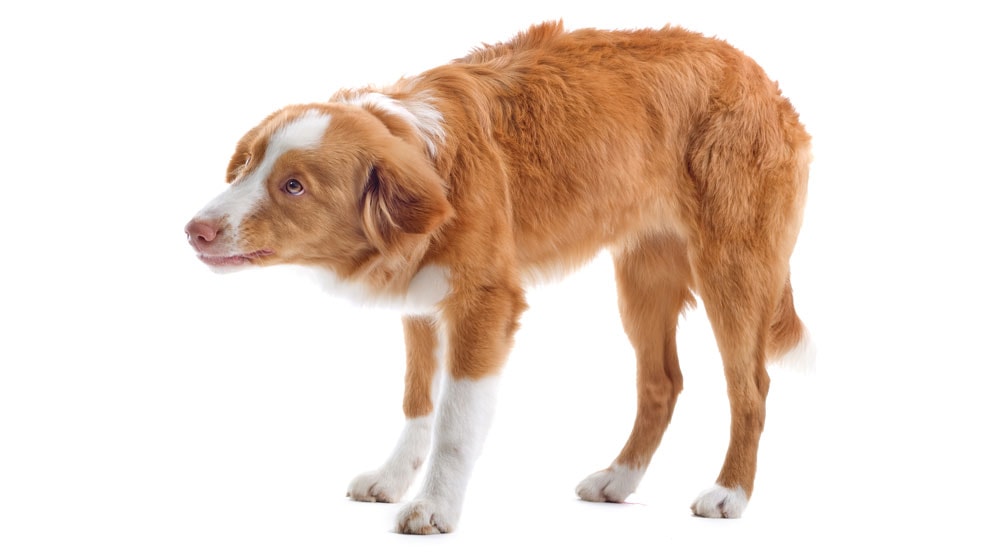There are many reasons why your dog might roll on his or her back. Here’s an overview of the most common reasons, along with tips for identifying the most likely cause of this dog behavior.
Contents
- The Dog Might Be Playing With Other Dogs
- The Dog May Want to Avoid Conflict
- The Dog Might Want a Belly Rub (Rolls When You Pet Him)
- The Dog Might Be Scratching His Back or Grooming (Rolls and Wiggles)
- The Dog Might Be Rolling In a Scent (Or Smelly Things!)
- The Dog May Just Find it Comfortable
- A Word About “Alpha Rolls”
- Summary
In some cases, the answer is simply that the dog wants to scratch his back or roll in a scent. Back rolling can also be a sign of fear, anxiety, or an attempt to defuse a conflict. But in other situations, it’s linked to play and happiness…no wonder many dog owners get confused!
As you can tell, there’s no single answer to “why do dogs roll on their backs?” The key is to examine other body language clues and your dog’s current environment. Let’s take a closer look at the most common reasons for rolling over.
The Dog Might Be Playing With Other Dogs
Many people assume that a dog feels threatened when he shows his belly when playing with another dog. It’s certainly true that a dog might use rolling over as a way to diffuse a situation they perceive as too rough or aggressive.
However, a recent study showed that rolling over is more likely to be used as a way to facilitate play, rather than stop it.
Researchers observed that larger dogs were more likely to roll over than smaller ones. This could be a form of self-handicapping, which allows dogs of different sizes to play. They also noted that the position was only held for very short periods. If rolling over was a sign of appeasement, the dog would usually hold this position for longer.
The study concluded that, during active play sessions, rolling onto the back allows the dog to adopt a better offensive or defensive position in the game. Basically, it allows them to signal they are playing, while getting ready to block or deliver play bites.
The Dog May Want to Avoid Conflict
Rolling can sometimes be used as a form of passive de-escalation. In other words, your dog could be trying to avoid conflict and show they’re not a threat.
There are many situations where this behavior could be seen. When your dog meets another dog that’s growling or barking, for example, they may roll over to try to prevent further aggression.
If you’ve adopted a dog that has been mistreated in the past, you may find they roll over when voices are raised in their presence. This may be an attempt to diffuse what they perceive as a hostile situation. A dog may also roll over when they feel uncomfortable or nervous.
If the dog is displaying signs of being fearful, don’t crowd them or stroke their belly. Instead, try to remove them from the situation or environment that’s making them feel uncomfortable.
Tip: You should also keep a look out for other signs of stress in your dog. They may be scratching excessively, licking their lips, yawning, not making eye contact, panting or trembling.
The Dog Might Want a Belly Rub (Rolls When You Pet Him)
As many dog owners know, some dogs roll onto their backs simply because they enjoy belly rubs. It’s a sign they feel relaxed and calm in their current environment.
Of course, the difficulty is judging when a dog is rolling on his back because he’s truly relaxed, or when there’s another reason, such as anxiety.
If your dog rolls onto their back around an unfamiliar person, it would be best for them to avoid rubbing the belly, unless it’s obvious the dog is feeling relaxed. If the situation is misread, and your dog is feeling anxious, it could cause additional stress.
Even if your pet loves belly rubs, don’t forcefully roll them onto their back for a stroke. This can cause anxiety, stress, and eventually ruin the enjoyment of belly rubs. Only pet them like this when they roll over voluntarily.
The Dog Might Be Scratching His Back or Grooming (Rolls and Wiggles)
It can be tricky for dogs to groom their backs, so rolling might just be an attempt to scratch this area. This is often accompanied with lots of wiggling to try and itch the right spot.
You may notice this behavior more in dogs that moult excessively. As the hair is beginning to come loose, some dogs learn that rolling helps to dislodge it.
The Dog Might Be Rolling In a Scent (Or Smelly Things!)
When it comes to my dog Annie, the most common reason I see her rolling on her back is because she is covering herself in something smelly. She has a habit of rolling in poop or dead animals. Disgusting to me, but a perfectly natural behavior for her.
There isn’t conclusive evidence to tell us why dogs are so drawn to rolling in odorous items. One compelling theory is that ancestral wild dogs would do it to mask their scent from predators, prey, or other dogs in their territory. Wolves also roll in scat to allow them to carry the scent back to the pack for hunting purposes.
It could, however, just be as simple as the fact that your dog likes the smells, and they get enjoyment out of rolling in them.
If your dog is a serial poop roller, don’t punish them for exhibiting this natural behavior. Instead, you may want to keep them on a leash in areas where the temptation is too much and make sure you’re armed with a good odor control shampoo!
The Dog May Just Find it Comfortable
Some dogs like to sleep on their back. If your dog does this, it’s usually an indication that they’re feeling very relaxed in their environment.
Certain breeds will adopt this position when sleeping more frequently. Greyhounds, for example, often lie on their backs. It’s so common, it has even been given a name. So, don’t panic if you see them lying with all four legs sticking up into the air, looking like a dead insect. They’re just roaching.

A Word About “Alpha Rolls”
An “Alpha Roll” is an outdated training method where a dog is forcibly rolled onto its back. They’re held in this vulnerable position in an attempt for the handler to exert their “dominance,” often as a punishment for an undesirable behavior.
Trainers that advocate this technique claim it’s something the “alpha” wolf would do to keep their pack in line and that it also works with dogs.
Studies have shown that this type of behavior is actually rarely seen in wolves. They don’t have the hierarchical struggle that the theory is based around. Also, dogs have vastly different behaviors from their wolf ancestors anyway. So, applying these pack principles to a domestic dog doesn’t make sense.
Using forceful methods like this can result in your dog becoming fearful or they may try to fight back. And, of course, you aren’t going to build a loving and trusting bond with your dog using these methods.
By using science-based, positive reinforcement training techniques instead, you’ll have more success, a happier dog, and a stronger bond.
Summary
Dogs roll on their back for a variety of reasons. It doesn’t always mean they want a belly rub or scratch.
Sometimes the dog may be trying to scratch his back, sleep, or facilitate play. In other situations, it could be a sign of stress, or an attempt to diffuse potential conflict.
Do you have any questions about why dogs roll on their backs? Let us know in the comments section below. You may also want to read our guide to why dogs roll around after eating.




